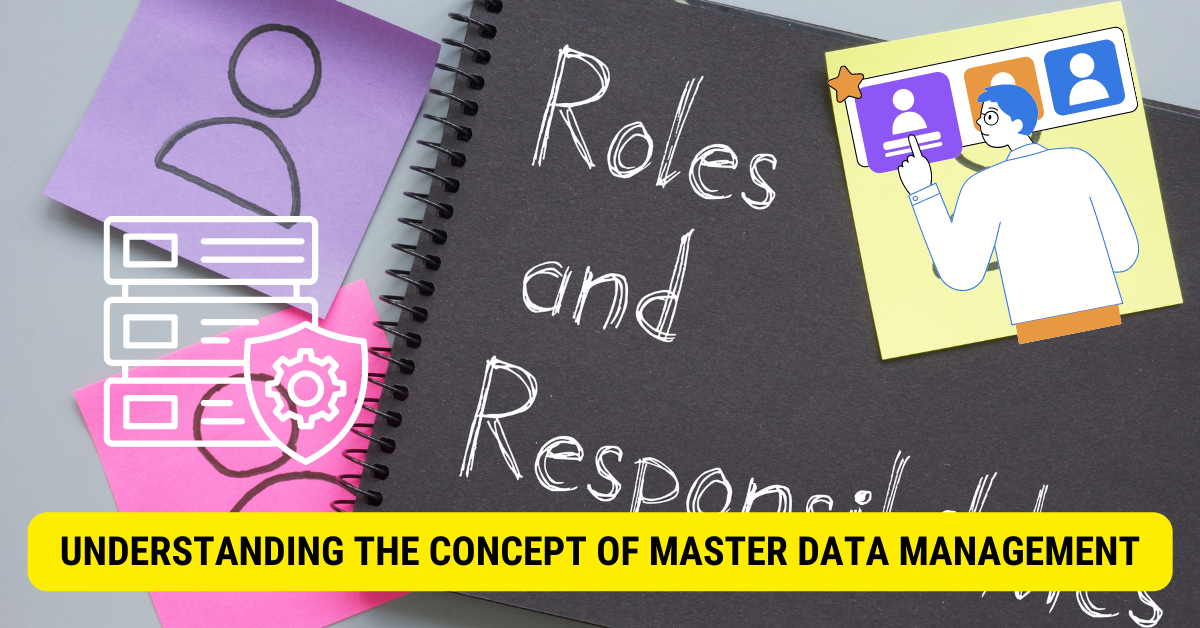The Security Master Data Management position role involves managing and maintaining the security-related data within an organization.
In today’s rapidly evolving digital landscape, the role of a Security Master Data Manager has become increasingly critical. These professionals oversee and manage a company’s master data, ensuring its integrity, accuracy, and security. To understand the significance of this position, it is important first to grasp the concept of master data management.
Understanding the Concept of Master Data Management

Master data management (MDM)
Master data management (MDM) refers to creating and maintaining a single, consistent, and accurate source of truth for an organization’s critical data. It encompasses all the core data entities essential for a company’s day-to-day operations, including customers, products, employees, suppliers, etc. The main objective of MDM is to provide a standardized and reliable foundation for decision-making and operational efficiency.
By centralizing and harmonizing master data, organizations can avoid data inconsistencies, redundancies, and inaccuracies that may arise from having multiple sources or siloed systems. This ensures that crucial business processes, such as sales, marketing, finance, and supply chain management, can rely on accurate and up-to-date information.
Master data management involves various steps and considerations. It starts with identifying the key data entities to manage and establishing data governance policies and procedures. Data governance ensures clear guidelines and responsibilities for managing and maintaining master data. It also involves defining data stewardship roles and enforcing compliance with regulatory requirements.
Organizations focus on data quality management once the data governance framework is in place. This involves implementing processes and tools to measure, monitor, and improve the quality of master data. Data accuracy, completeness, consistency, and timeliness are assessed continuously to identify and rectify any data issues proactively. This ensures that the master data is reliable and trustworthy.
Data integration is another critical component of master data management. In today’s interconnected business environment, master data often resides in multiple systems and applications. Data integration consolidates and integrates data from various sources to create a unified and accurate representation of master data. This involves performing data mappings, transformations, and cleansing to ensure data consistency and coherence across the organization.
Data security is a paramount concern in master data management. With the increasing number of data breaches and cybersecurity threats, organizations must implement robust security measures to safeguard master data from unauthorized access, theft, or tampering. Encryption, access controls, authentication mechanisms, and regular security audits are key practices to protect master data.
Lastly, master data has a lifecycle that involves creation, updating, archiving, and retirement. Data lifecycle management focuses on defining and implementing processes and tools to manage the entire lifecycle of master data. It ensures data is accurate, relevant, and current while minimizing storage costs and complying with data retention policies.
The Importance of Master Data Management
Master data is the backbone of any business, enabling seamless operations and facilitating informed decision-making. Without an effective master data management strategy, companies risk making decisions based on unreliable or incomplete information, leading to financial losses, missed opportunities, and damaged customer relationships.
Furthermore, as organizations increasingly rely on digital technologies and data-driven insights, the need for accurate and secure master data becomes even more vital. Master data is at the core of advanced analytics, artificial intelligence, and machine learning, providing the foundation for business intelligence and predictive modeling. Without clean and consistent master data, these technologies will yield incomplete or erroneous results.
Key Components of Master Data Management
A comprehensive master data management framework comprises several key components: data governance, quality management, integration, security, and lifecycle management. Let’s explore these components in more detail:
- Data Governance: This component focuses on establishing policies, procedures, and guidelines to ensure the integrity, privacy, security, and accessibility of master data. It involves defining roles and responsibilities, establishing data stewardship, and enforcing compliance with regulatory requirements.
- Data Quality Management: Data quality is paramount in master data management. This component focuses on implementing processes and tools to measure, monitor, and improve the quality of master data. Organizations can proactively identify and rectify data issues by assessing accuracy, completeness, consistency, and timeliness.
- Data Integration: In today’s interconnected business environment, master data often resides in multiple systems and applications. Data integration consolidates and integrates data from various sources to create a unified and accurate representation of master data. This involves performing data mappings, transformations, and cleansing to ensure data consistency and coherence across the organization.
- Data Security: With the increasing number of data breaches and cybersecurity threats, data security is critical to master data management. This component focuses on implementing robust security measures to safeguard master data from unauthorized access, theft, or tampering. Encryption, access controls, authentication mechanisms, and regular security audits are key practices to protect master data.
- Data Lifecycle Management: Master data has a lifecycle that involves creation, update, archiving, and retirement. This component focuses on defining and implementing processes and tools to manage the entire lifecycle of master data. It ensures data is accurate, relevant, and current while minimizing storage costs and complying with data retention policies.
- Data Governance: Data governance is a critical component of master data management. It involves establishing policies, procedures, and guidelines to ensure the integrity, privacy, security, and accessibility of master data. Data governance defines roles and responsibilities, establishes data stewardship, and enforces compliance with regulatory requirements.
The Role of a Security Master Data Manager

Now that we have a foundational understanding of master data management, let’s delve into the responsibilities and duties of a Security Master Data Manager.
Responsibilities and Duties
A Security Master Data Manager is primarily responsible for administering and maintaining the security aspects of master data. This includes:
- Designing and implementing security controls and processes to protect master data from unauthorized access, breaches, and cyber threats.
- Collaborating with cross-functional teams to establish and enforce data governance policies for master data security.
- Performing regular audits and assessments to identify potential vulnerabilities and address security gaps.
- Monitoring user access controls and permissions to ensure compliance with security policies and regulatory requirements.
- Developing and delivering security training programs to educate employees on best practices for master data security.
- Contributing to incident response and data breach management, including investigation, mitigation, and communication.
Required Skills and Qualifications
To excel in this role, a Security Master Data Manager should possess diverse skills and qualifications. Some key requirements include:
- In-depth knowledge of master data management principles, practices, and tools.
- Expertise in data security, privacy, and compliance regulations, such as GDPR or CCPA.
- Proficiency in risk assessment and mitigation techniques.
- Strong analytical and problem-solving skills.
- Excellent communication and collaboration abilities.
- Attention to detail and a commitment to accuracy.
- Project management skills to oversee the implementation of security initiatives.
The Intersection of Security and Master Data Management

In today’s data-driven world, the convergence of security and master data management is crucial. Let’s explore why data security plays a vital role in the realm of master data management.
The Importance of Data Security
Data security is paramount for any organization, regardless of size or industry. With the growing frequency and sophistication of cyber threats, protecting sensitive and confidential data has become a top priority. Master data, the foundational data that drives critical business operations, requires special attention to security. Breaches or compromises in master data can have far-reaching consequences, including financial losses, reputational damage, legal repercussions, and regulatory non-compliance.
How Security Master Data Managers Ensure Data Protection
Security Master Data Managers play a vital role in ensuring the protection of master data. They employ technical measures, policies, and processes to safeguard data integrity, confidentiality, and availability. Some key strategies and practices utilized by Security Master Data Managers include:
- Implementing robust access controls and authentication mechanisms to limit data access to authorized personnel only.
- Encrypting sensitive data to prevent unauthorized viewing or tampering.
- Monitoring and detecting anomalous activities or potential security breaches through security monitoring tools and techniques.
- Regularly backing up data to ensure data recoverability during a breach or data loss.
- Performing vulnerability assessments and penetration testing to identify and remediate security vulnerabilities.
- Keeping abreast of the latest security threats, best practices, and regulatory requirements to ensure compliance and proactively mitigate risks.
Career Path for a Security Master Data Manager
For individuals interested in pursuing a career as a Security Master Data Manager, understanding the educational requirements and career progression opportunities is essential.
Educational Requirements
This profession requires a bachelor’s degree in information technology, computer science, or a related field. However, some organizations may also value relevant certifications, such as Certified Information Systems Security Professional (CISSP) or Certified Information Privacy Professional (CIPP), as evidence of specialized data security and privacy knowledge.
Career Progression and Opportunities
As organizations continue to know the importance of master data management and data security, career opportunities in this field are expected to grow. With experience and expertise, Security Master Data Managers can progress to managerial or leadership roles, such as Chief Information Security Officer or Director of Data Governance. They may also explore consulting or independent contracting opportunities, guiding organizations in their master data management and security initiatives.
Case Study: The Impact of a Security Master Data Manager in a Company
To understand the tangible benefits of having a Security Master Data Manager, let’s examine a case study showcasing the transformation of implementing master data management.
Before and After the Implementation of Master Data Management
Company XYZ, a multinational manufacturing organization, struggled with disparate and inconsistent master data across its various divisions and regions. This lack of data standardization resulted in inefficiencies, costly errors, and missed opportunities. Recognizing the need for a robust master data management strategy, Company XYZ appointed a Security Master Data Manager to spearhead the initiative.
Under the leadership of the Security Master Data Manager, the company embarked on a comprehensive master data management program. The goals were to ensure data accuracy, streamline business processes, and enhance decision-making. The implementation involved:
- Performing a thorough assessment of existing data sources, systems, and processes to identify pain points and areas for improvement.
- Collaborating with key organizational stakeholders to establish a unified data governance framework.
- Implementing data quality management tools and processes to cleanse and harmonize master data.
- Integrating data from disparate sources into a centralized data repository, leveraging data integration technologies and methodologies.
- Enhancing data security measures and implementing access controls to protect sensitive master data.
The Role of the Security Master Data Manager in this Transformation
The Security Master Data Manager successfully transformed Company XYZ’s master data management. Their contributions included:
- Ensuring the implementation of robust security measures to protect sensitive master data from unauthorized access or breaches.
- Collaborating with data stewards and other stakeholders to establish governance policies and processes.
- Implementing data quality management practices to cleanse and standardize master data.
- Providing training and support to employees to raise awareness and promote adherence to data security protocols.
- Driving the adoption of master data management practices across the organization through change management initiatives.
As a result of the Security Master Data Manager’s efforts, Company XYZ experienced significant improvements. Data accuracy and reliability increased, enhancing decision-making and improving operational efficiency. Furthermore, the company saved costs by eliminating redundant and inconsistent data sources and streamlining business processes.
Key Takeaways
- The Security Master Data Management (MDM) position oversees the security aspects of an organization’s MDM program.
- The role involves managing and protecting the integrity, availability, and confidentiality of master data used across the organization.
- The Security MDM position ensures compliance with data protection regulations and industry best practices.
- They develop and enforce MDM system data governance policies, procedures, and controls.
- They collaborate with cross-functional teams to identify and mitigate data security risks.
- The Security MDM position may involve implementing access controls, encryption, and data classification mechanisms.
- They conduct regular audits and assessments to identify vulnerabilities and implement remediation measures.
- This role requires knowledge of data security frameworks, MDM technologies, and data governance principles.
FAQs
What is Master Data Management (MDM)?
Master Data Management is a discipline that involves managing and organizing the critical data assets of an organization. It aims to ensure the accuracy, consistency, and reliability of master data across different systems and applications.
How does the Security MDM role differ from other security roles?
The Security MDM role focuses on securing and protecting master data within an MDM program. It involves understanding MDM systems’ unique challenges and requirements and implementing security controls and measures specific to master data.
What skills and qualifications are typically required for a Security MDM position? Typical qualifications for a Security MDM position may include a strong background in data security, experience with MDM technologies, knowledge of data protection regulations, data governance expertise, and proficiency in risk assessment and mitigation strategies.
Conclusion
In today’s data-driven business landscape, the Security Master Data Management position is crucial in implementing and maintaining robust master data management strategies. By ensuring the security, accuracy, and integrity of master data, Security Master Data Managers enable organizations to leverage their data assets effectively, drive operational excellence, and make informed decisions. With the increasing importance of data security and compliance, this role presents excellent opportunities for individuals seeking a meaningful and impactful career in data management and cybersecurity.
